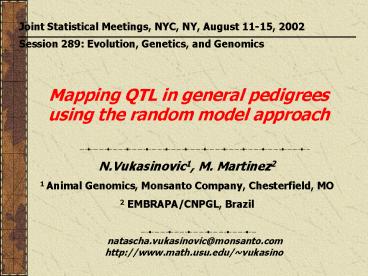Mapping QTL in general pedigrees using the random model approach - PowerPoint PPT Presentation
1 / 17
Title:
Mapping QTL in general pedigrees using the random model approach
Description:
Probability that gamete in i, inherited. from x is IBD to gamete in j, inherited ... Probability that gamete is IBD to. paternal (or maternal) allele of x ... – PowerPoint PPT presentation
Number of Views:69
Avg rating:3.0/5.0
Title: Mapping QTL in general pedigrees using the random model approach
1
Mapping QTL in general pedigrees using the random
model approach
Joint Statistical Meetings, NYC, NY, August
11-15, 2002 Session 289 Evolution, Genetics, and
Genomics
- N.Vukasinovic1, M. Martinez2
- 1 Animal Genomics, Monsanto Company,
Chesterfield, MO - 2 EMBRAPA/CNPGL, Brazil
- natascha.vukasinovic_at_monsanto.com
- http//www.math.usu.edu/vukasino
2
Introduction
3
Introduction
4
QTL mapping
- QTL detection
- check if QTL is present
- QTL location
- determine the position of the QTL on the
chromosome - QTL effect
- estimate the magnitude of allelic effect or
variance of the QTL
5
Random model approach
- Estimates variance due to QTL.
- Based on phenotypic similarity between
relatives. - Does not require assumptions about genetic
model at the QTL. - Appropriate for outbred populations.
6
Statistical model
- Phenotypic value
- yij m QTLij polygenesij errorij
- Phenotypic variance
- Var (yij) s2 s2QTL s2poly s2error
- Covariance between two relatives j and j
- Cov (yij, yij) s2QTL rjj s2poly
- proportion of alleles IBD shared at
QTL - rjj coefficient of relationship between
j and j
7
Estimating
- Sib-pair approach
- is a linear function of proportions IBD
shared by two sibs at linked marker loci. - Procedures well established for unrelated full-
and halfsib families. - No efficient procedures for general pedigrees
- Animal pedigrees too complicated for algorithms
used for human pedigrees.
8
Estimating
- Pong-Wong et al. (2001)GSE 33453-471
- Fast, partly recursive deterministic method
to calculate IBD shared - between ancestors and descendants
- Recursive method for single marker
- between sibs
- Method for multiple markers
- Uses informative markers only (closest
informative marker bracket).
9
Informative marker brackets
?
?
10
Informative marker brackets
a b c
a b c
?
?
11
Informative marker brackets
AA BB CC
aa bb cc
?
Aa Bb Cc
aa Bb cc
?
Aa BB Cc
aa BB Cc
aa Bb Cc
12
IBD between ancestors descendants
13
Calculating PDQs
q1 - recombination between 1st marker and QTL q2
- recombination between QTL and 2nd marker q -
recombination between 2 flanking markers
14
IBD among sibs
q1 - recombination between 1st marker and QTL q2
- recombination between QTL and 2nd marker q -
recombination between 2 flanking markers
15
Using IBD in QTL mapping
- All calculations done separately for paternal and
maternal allele - G - gametic IBD matrix
- Order 2n
- Q - matrix of IBD at individual level
- Order n
- where
16
Concerns
- G (and Q) may not be positive definite.
- The method may not work well when markers are not
informative. - Is the method general enough?
- What about really large pedigrees?
- What about loops and inbreeding?
17
Current work
- Simulation studies to assess the performance of
this method using - Pedigrees of different size and complexity level
- Different marker density and informativeness
- Different size / position of QTL
- Results to be shown in the paper (JSM ProCDings,
2002).

